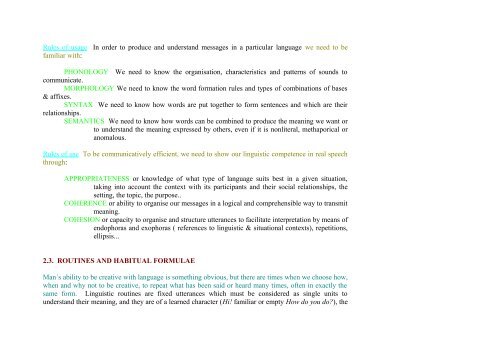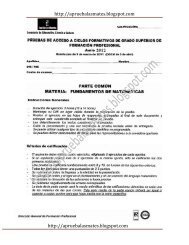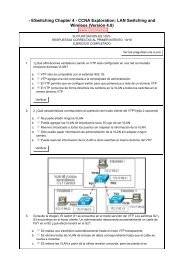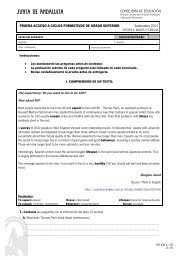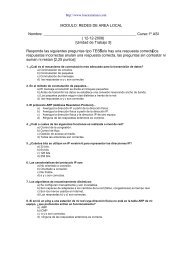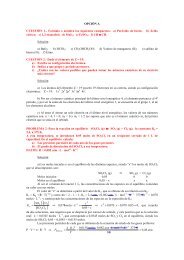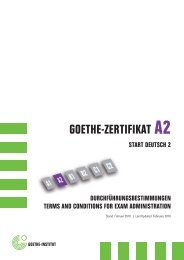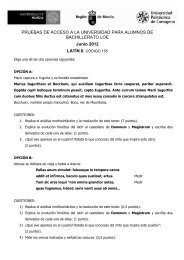- Page 1 and 2: Tema-1 “ LANGUAGE AS COMMUNICATIO
- Page 3 and 4: As we can see with these two defini
- Page 5 and 6: which language is used. Several oth
- Page 7 and 8: ules of his language which allows h
- Page 9 and 10: On the other hand, Canale defined D
- Page 11 and 12: In a syllabic system each grapheme
- Page 13 and 14: From this definition we can conclud
- Page 15 and 16: The first of these areas, Language,
- Page 17 and 18: BIBLIOGRAPHY The bibliography used
- Page 19 and 20: 0. INTRODUCTION. Traditional foreig
- Page 21 and 22: - Displacement: it is possible to t
- Page 23 and 24: 2.- The interpersonal function is t
- Page 25 and 26: CANALE (1980) defined discourse com
- Page 27 and 28: Myths and legends of the supernatur
- Page 29 and 30: - It developes naturally in childre
- Page 31 and 32: 5.- Finally we can say that written
- Page 33 and 34: or medium are more variable and les
- Page 35 and 36: these are referred to as noise or e
- Page 37 and 38: As we can infer from the examples t
- Page 39 and 40: - Halliday, M. A. K. Spoken and wri
- Page 41 and 42: From a psychological point of view,
- Page 43: INTONATION is the falling and risin
- Page 47 and 48: Since classical times, there have b
- Page 49 and 50: - there is more lexical density in
- Page 51 and 52: For this characteristic structure,
- Page 53 and 54: At the turn of the century, the Eng
- Page 55 and 56: cataphora) and the external aspects
- Page 57 and 58: the relationship between the schema
- Page 59 and 60: Learners can understand much more t
- Page 61 and 62: It is very suitable for our primary
- Page 63 and 64: Canale and Swain developed the idea
- Page 65 and 66: All material used in teaching sound
- Page 67 and 68: The reason for this neglect was tha
- Page 69 and 70: origin and so on of speaker and hea
- Page 71 and 72: The cultural specificness of these
- Page 73 and 74: different-size chairs beside it.Thi
- Page 75 and 76: TOPIC 3 DEVELOPMENT OF THE FOUR BAS
- Page 77 and 78: Within this communicative competenc
- Page 79 and 80: 2. SKIMMING or to identify the prin
- Page 81 and 82: 7. make up our mind about what proc
- Page 83 and 84: -Materials: instructions for games.
- Page 85 and 86: ) Elicit the new language. c) Focus
- Page 87 and 88: taste for reading. There are publis
- Page 89 and 90: -SPECIFIC UNDERSTANDING are subsequ
- Page 91 and 92: give us material to produce texts (
- Page 93 and 94: He said that competence by itself i
- Page 95 and 96:
4. BIBLIOGRAPHY The royal decree 1
- Page 97 and 98:
Sociocultural expressions are shown
- Page 99 and 100:
PART TWO: PRACTICAL DEVELOPMENT 1.
- Page 101 and 102:
Hence, communication should begin i
- Page 103 and 104:
cultures of modern Europe. He point
- Page 105 and 106:
2.4. The importance of having mater
- Page 107 and 108:
strips, proverbs and pictures; a ta
- Page 109 and 110:
PART TWO: PRACTICAL DEVELOPMENT 1.
- Page 111 and 112:
6.1. Brain-storming: The students (
- Page 113 and 114:
geographical, historical and cultur
- Page 115 and 116:
From 1650 to 1850 there is a change
- Page 117 and 118:
Its capital is Washington. The firs
- Page 119 and 120:
3.1.- HOW CAN WE TEACH ENGLICH CIVI
- Page 121 and 122:
3) Children must therefore learn
- Page 123 and 124:
THE TWO-WORD STAGE Around the time
- Page 125 and 126:
THEORIES OF CHILD LANGUAGE ACQUISIS
- Page 127 and 128:
Thus, a third theory suggests that
- Page 129 and 130:
comprehension competencies can be d
- Page 131 and 132:
THE MONITOR HYPOTHESIS The monitor
- Page 133 and 134:
THE AFFECTIVE FILTER HYPOTHESIS It
- Page 135 and 136:
ule) need to be fulfilled before th
- Page 137 and 138:
Interlingual and developmental erro
- Page 139 and 140:
Tema-6 The unit under consideration
- Page 141 and 142:
The most interesting field of study
- Page 143 and 144:
create a program based on the areas
- Page 145 and 146:
Vigotsky establishes three main sta
- Page 147 and 148:
As we have explained, a basic diffe
- Page 149 and 150:
However, just from the second half
- Page 151 and 152:
THE MAIN LINGUISTIC SCIENCES. Phone
- Page 153 and 154:
It is a modern science which consid
- Page 155 and 156:
for Behaviourism is not the meaning
- Page 157 and 158:
Instrumental motivation, dealing wi
- Page 159 and 160:
SIMILARITIES AND DIFFERENCES BETWEE
- Page 161 and 162:
In some cases children can acquire
- Page 163 and 164:
III.- LISTENING 2 1.- Definition of
- Page 165 and 166:
IV.- SPEAKING 7 - Following instruc
- Page 167 and 168:
I.- INTRODUCTION In this topic, we
- Page 169 and 170:
1.- Definition of the process Let u
- Page 171 and 172:
Secondly, we must help the SS to de
- Page 173 and 174:
Prediction exercises encourage the
- Page 175 and 176:
Many games depend for their success
- Page 177 and 178:
Activities must provide opportuniti
- Page 179 and 180:
Pairwork activities provide SS with
- Page 181 and 182:
elicit or pre-teach the language SS
- Page 183 and 184:
TOPIC 7. FOREIGN LANGUAGE SPEECH. T
- Page 185 and 186:
The first stage in the listening sk
- Page 187 and 188:
6. Recognising discourse patterns a
- Page 189 and 190:
might use “teacher talk” when p
- Page 191 and 192:
Before reading, children must know
- Page 193 and 194:
Story construction (small pieces of
- Page 195 and 196:
In class we have to exploit the ill
- Page 197 and 198:
a) Type one skills, are those opera
- Page 199 and 200:
In the last part of the unit, I am
- Page 201 and 202:
e) Correcting mistakes in written s
- Page 203 and 204:
system are acquired; the consolidat
- Page 205 and 206:
Reaching this point, the student is
- Page 207 and 208:
At first, the short of games propos
- Page 209 and 210:
As examples we can include reading
- Page 211 and 212:
The creativity since when we write
- Page 213 and 214:
Later, the students can write lette
- Page 215 and 216:
3. Rhythm in the Canarian Dialect/
- Page 217 and 218:
Stress concerns the relative promin
- Page 219 and 220:
Ex: ‘phoneme pho’nemic f. Words
- Page 221 and 222:
Some writers have developed theorie
- Page 223 and 224:
this focus accent goes on the last
- Page 225 and 226:
It is common in everyday usage: Ex:
- Page 227 and 228:
1.4.3.- Articulación. 2.- MODELOS
- Page 229 and 230:
1.2.- ¿Qué inglés? ¿Acentos? Lo
- Page 231 and 232:
Las cuerdas vocales son dos bandas
- Page 233 and 234:
Podemos distinguir en la lengua tre
- Page 235 and 236:
español. Si la imitación no es su
- Page 237 and 238:
Inglés/inglés: eat, eat (igual) f
- Page 239 and 240:
cada fonema tiene una representaci
- Page 241 and 242:
Obsérvese el fonema [i] en mountai
- Page 243 and 244:
Ortografía: ar (+ consonante) car,
- Page 245 and 246:
(w)a walk, wall o+f, th, s often, c
- Page 247 and 248:
adquirirse directamente por imitaci
- Page 249 and 250:
Ortografía: a along e sentence o L
- Page 251 and 252:
- /ai/. El diptongo [ai] de child s
- Page 253 and 254:
ier fierce -/e /. El diptongo de c
- Page 255 and 256:
- /d/. La d de do se articula con l
- Page 257 and 258:
vocal; y el morfema del plural o de
- Page 259 and 260:
calidad que requiere el sonido. Se
- Page 261 and 262:
confundirlo con la g fricativa espa
- Page 263 and 264:
primera sílaba acentuada de la ora
- Page 265 and 266:
d) preguntas confirmativas cuando n
- Page 267 and 268:
Para corregir errores de pronunciac
- Page 269 and 270:
2. INTRODUCTION The most noticeable
- Page 271 and 272:
Ex: ‘kingly ‘kingliness un’ki
- Page 273 and 274:
‘Jane ‘’and her ‘mother are
- Page 275 and 276:
It often occurs in the nucleus of a
- Page 277 and 278:
5.EL PROCESO DE EVALUACIÓN Y LA TO
- Page 279 and 280:
¿QUÉ ES EL BLISSIMBOLISMO? Sistem
- Page 281 and 282:
Configuración de la mano Localizac
- Page 283 and 284:
EVALUACIÓN DE LOS MÉTODOS LENGUAJ
- Page 285 and 286:
ANEXO TEMA 10 APLICACIÓN DIDÁCTIC
- Page 287 and 288:
Con estas actividades, todos los ni
- Page 289 and 290:
If the first part of a compound wor
- Page 291 and 292:
- A group of words which are common
- Page 293 and 294:
- We may also ask the students to g
- Page 295 and 296:
Number prefixes Tri-: trident Conve
- Page 297 and 298:
For instance, Spanish students must
- Page 299 and 300:
1. CONVERSION It is a process in wh
- Page 301 and 302:
*At Primary School we know the voca
- Page 303 and 304:
G. Guessing the meaning from contex
- Page 305 and 306:
2.1. Meaning. 2.2. Word formation.
- Page 307 and 308:
The first thing to realise about vo
- Page 309 and 310:
Ÿ Offering things: Do you want...?
- Page 311 and 312:
Harmer J. The Practice of English L
- Page 313 and 314:
- Can / could I see you tonight? Wh
- Page 315 and 316:
4. ACTIVITIES USED IN TEACHING AND
- Page 317 and 318:
contexts. This will facilitate both
- Page 319 and 320:
Conversion of secondary word-class.
- Page 321 and 322:
It denotes he subtraction of one or
- Page 323 and 324:
d) We can present vocabulary by mea
- Page 325 and 326:
together all the English lexemes fo
- Page 327 and 328:
done. Would you like another helpin
- Page 329 and 330:
d) The use of mime, action and gest
- Page 331 and 332:
Apart from learning a language, if
- Page 333 and 334:
Statements can be isolated: a) Some
- Page 335 and 336:
5) Lexical irregular verbs: from 3
- Page 337 and 338:
We must make the difference between
- Page 339 and 340:
language will be to communicate wit
- Page 341 and 342:
1. Los límites del área de estudi
- Page 343 and 344:
Ejemplo 1: ORACIÓN SINTAGMA NOMINA
- Page 345 and 346:
- This/that/the. - Imperativos (sit
- Page 347 and 348:
- Telefonear a alguien. - Alquilar
- Page 349 and 350:
- Generalizar. - Cuantificar. - Gra
- Page 351 and 352:
A car I buy a car A comb I buy a co
- Page 353 and 354:
I write to my friends very often -
- Page 355 and 356:
- I'm sure my brother isn't studyin
- Page 357 and 358:
c) Trabajo por parejas: You are tal
- Page 359 and 360:
de la enseñanza de la lenguas. Per
- Page 361 and 362:
NOTA FINAL Y BALANCE a) El imperio
- Page 363 and 364:
4. Vive hora tras hora en un contex
- Page 365 and 366:
punto, al ser una metodología acti
- Page 367 and 368:
Pero de nuevo, sobre la novedad de
- Page 369 and 370:
Este método aporta una novedad sin
- Page 371 and 372:
1. El alumno es sordo a los sonidos
- Page 373 and 374:
El método situacional es en buena
- Page 375 and 376:
La estructura Haría usted el favor
- Page 377 and 378:
3. BIBLIOGRAPHY. 0. INTRODUCTION. 2
- Page 379 and 380:
Central. The American linguist Edwa
- Page 381 and 382:
1.2. Approach Approach refers to th
- Page 383 and 384:
methods may focus On communication
- Page 385 and 386:
concern for variation among learner
- Page 387 and 388:
development does not always proceed
- Page 389 and 390:
speaker's knowledge, and he replace
- Page 391 and 392:
Sociocultural competence refers to
- Page 393 and 394:
- a communicative purpose - content
- Page 395 and 396:
Exchanging letters is a type of act
- Page 397 and 398:
2.3. Procedure. Because of the wide
- Page 399 and 400:
According to this it is clear that
- Page 401 and 402:
Therefore, if both sentence structu
- Page 403 and 404:
2. Types of storybooks. There is a
- Page 405 and 406:
PART ONE: TABLE OF CONTENTS 1. INTR
- Page 407 and 408:
2.4. British Authors and Texts Beow
- Page 409 and 410:
civil war is intriguing and full of
- Page 411 and 412:
Mary Wollstonecraft (1759-97) is a
- Page 413 and 414:
interesting, especially the part th
- Page 415 and 416:
Though it did have a few high spots
- Page 417 and 418:
example of the impact of American v
- Page 419 and 420:
involve children. And Toni Morrison
- Page 421 and 422:
- vocabulary: words related to lite
- Page 423 and 424:
The pupil of this age always desire
- Page 425 and 426:
We should not forget famous authors
- Page 427 and 428:
LIMERICKS Limercks are funny five -
- Page 429 and 430:
abandonar -abandone junto con-next
- Page 431 and 432:
0. INTRODUCTION This unit will deal
- Page 433 and 434:
Robison Crusoe, by Daniel Defoe and
- Page 435 and 436:
specially because of repetitions. A
- Page 437 and 438:
3. Encourage participation 4. Motiv
- Page 439 and 440:
LA LITERATURA INFANTIL EN LENGUA IN
- Page 441 and 442:
- Harmony is achieved by, when choo
- Page 443 and 444:
Kenneth Grahame understood children
- Page 445 and 446:
Sir Philip Sydney. He was born in 1
- Page 447 and 448:
“As there was no money, Ginger an
- Page 449 and 450:
General curriculum. Most stories ca
- Page 451 and 452:
Advantages: the children are probab
- Page 453 and 454:
- Clement Moore: “Night before Ch
- Page 455 and 456:
In the pedagogy of second language
- Page 457 and 458:
and non oral aspects (gestures) of
- Page 459 and 460:
First listening, first contacts. In
- Page 461 and 462:
d) Reconstruction of a song. The te
- Page 463 and 464:
1. It is easier to sing a language
- Page 465 and 466:
e) Write in Order: write in the cor
- Page 467 and 468:
2.2.1. - Juego de trotamundos. 2.2.
- Page 469 and 470:
El material. El lenguaje. Las cla
- Page 471 and 472:
animales, plantas, objetos, mobilia
- Page 473 and 474:
Algunos de los juegos que vamos a p
- Page 475 and 476:
elacionados con la comida. El que r
- Page 477 and 478:
Organización: Los alumnos, de form
- Page 479 and 480:
2.2. - Juegos de estructuras gramat
- Page 481 and 482:
Material: Ninguno. Agrupación: Tre
- Page 483 and 484:
Alternativa (sin dibujo): Para comp
- Page 485 and 486:
Organización: Los alumnos se divid
- Page 487 and 488:
Material: Una fotocopia de un plano
- Page 489 and 490:
The talking blackboard: In pairs. A
- Page 491 and 492:
The students learn sharing and join
- Page 493 and 494:
2. THE FOREIGN LANGUAGE AREA IN THE
- Page 495 and 496:
There are nine general objectives,
- Page 497 and 498:
B. WRITTEN COMMUNICATION USES AND F
- Page 499 and 500:
5.- To participate in simulated com
- Page 501 and 502:
1.- Regarding the school identity s
- Page 503 and 504:
The degree in which the abilities e
- Page 505 and 506:
To see this relation more clear, th
- Page 507 and 508:
Specific comprehension - Of informa
- Page 509 and 510:
- Total Physical Response ( TPR) ac
- Page 511 and 512:
(simulations, games, and role-plays
- Page 513 and 514:
Use verbal and non verbal strategie
- Page 515 and 516:
Now, we are going to deal with the
- Page 517 and 518:
BIBLIOGRAPHY. - Ley Orgánica 1/199
- Page 519 and 520:
+But language is not only an instru
- Page 521 and 522:
+The process of acquisition of a fo
- Page 523 and 524:
+The teaching of the English langua
- Page 525 and 526:
*Characteristics of the communicati
- Page 527 and 528:
-Tendency to use imaginatively and
- Page 529 and 530:
*Awareness of the specific elements
- Page 531 and 532:
*Spare time: games, songs, sports,
- Page 533 and 534:
1.3. EVALUATION CRITERIA 1. To reco
- Page 535 and 536:
6.To extract the general meaning an
- Page 537 and 538:
- The signs of identity. - The obje
- Page 539 and 540:
+The Educative Project will be a gu
- Page 541 and 542:
- To evaluale the transference of t
- Page 543 and 544:
+Regarding the latter, that is, the
- Page 545 and 546:
and a human/social experience. In t
- Page 547 and 548:
- We will also evaluate the curricu
- Page 549 and 550:
"In the context of the process of c
- Page 551 and 552:
- The signs of identity. - The obje
- Page 553 and 554:
first stage (lnfantil) and another
- Page 555 and 556:
- - - - Coherence Of the learning.
- Page 557 and 558:
stage, and' in the elaboration of t
- Page 559 and 560:
. Activities of extension: They let
- Page 561 and 562:
The will also evaluate the curricul
- Page 563 and 564:
of every cycle in order to determin
- Page 565 and 566:
efore, in order to see the changes
- Page 567 and 568:
. Pedagogic actions taken in the ca
- Page 569 and 570:
1. Pedagogic actions for the studen
- Page 571 and 572:
24 de Marzo de 1992). LT9 571
- Page 573 and 574:
-Awareness of the importance of ora
- Page 575 and 576:
-Awareness of the specific elements
- Page 577 and 578:
* Daily-life aspects: Timetables, h
- Page 579 and 580:
- - 2.3 Appraisal of the sociolingu
- Page 581 and 582:
6.To extract the general meaning an
- Page 583 and 584:
2.3 Evaluation criteria. 1.To recog
- Page 585 and 586:
6.To extract the general meaning an
- Page 587 and 588:
2.1.3.1.2. procedures: - To recogni
- Page 589 and 590:
k)Names of the letters in a foreign
- Page 591 and 592:
-Awareness and appraisal of the imp
- Page 593 and 594:
- - Curiosity and respect for the m
- Page 595 and 596:
2.3 Evaluation criteria. 1.To recog
- Page 597 and 598:
6.To extract the general meaning an
- Page 599 and 600:
599
- Page 601 and 602:
3.To extract specific information.
- Page 603 and 604:
9.To recognize, sorne sociocultural
- Page 605 and 606:
-Awareness of the importance of ora
- Page 607 and 608:
-Awareness of the specific elements
- Page 609 and 610:
* Daily-life aspects: Timetables, h
- Page 611 and 612:
- - Appraisal of the sociolinguisti
- Page 613 and 614:
3.To extract specific information.
- Page 615 and 616:
8.To produce short written texts. T
- Page 617 and 618:
7. BIBLIOGRAFÍA ..................
- Page 619 and 620:
por el profesorado de un centro y f
- Page 621 and 622:
el amplio repertorio de actividades
- Page 623 and 624:
habitaciones de la casa. Cuando se
- Page 625 and 626:
3. CRITERIOS PARA LA SECUENCIACIÓN
- Page 627 and 628:
Este objetivo está relacionado con
- Page 629 and 630:
Son objetos de enseñanza útiles y
- Page 631 and 632:
LA SELECCIÓN La selección de los
- Page 633 and 634:
cual, el aprendizaje de la lengua e
- Page 635 and 636:
Las actividades o tareas a realizar
- Page 637 and 638:
como: el lenguaje del profesor u ot
- Page 639 and 640:
mismo tiempo que se consigue memori
- Page 641 and 642:
volver atrás y volver a trabajarlo
- Page 643 and 644:
Bloque de Aspectos Socioculturales:
- Page 645 and 646:
13. - LOOK AND DO: Place the furnit
- Page 647 and 648:
Se trata de un juego de adivinació
- Page 649 and 650:
Is he in the piano? No. Is he under
- Page 651 and 652:
Se recomienda que los alumnos compl
- Page 653 and 654:
VARIOS (1992). Orientaciones para l
- Page 655 and 656:
Then, taking into account these bas
- Page 657 and 658:
2.1.- CRITERIA TO ESTABLISH THE SEQ
- Page 659 and 660:
3. The arrangement of objectives an
- Page 661 and 662:
‘To understand simple and oral wr
- Page 663 and 664:
- The level of correction The level
- Page 665 and 666:
Specific comprehension ´s your nam
- Page 667 and 668:
Obviously, as we haven’t got our
- Page 669 and 670:
2.2.- DIDACTIC UNITS: Now we are go
- Page 671 and 672:
Once we have explained the main cri
- Page 673 and 674:
(Se trata del tema 22 del temario e
- Page 675 and 676:
second language *Supplement the lea
- Page 677 and 678:
-looking for meaning from the conte
- Page 679 and 680:
complete the activities *Flexible g
- Page 681 and 682:
6.2.- Integrated Skills Our activit
- Page 683 and 684:
ASPECTS OF CLASS MANAGEMENT: PUPIL
- Page 685 and 686:
II. Divide the students into pairs
- Page 687 and 688:
Monitor the students’ performance
- Page 689 and 690:
On the other hand, w should plan re
- Page 691 and 692:
The learning and assessment activit
- Page 693 and 694:
* Lockstep - Advantages -Disadvanta
- Page 695 and 696:
OPOSICIONES A LA ESPECIALIDAD DE "I
- Page 697 and 698:
1. PRODUCING ENGLISH LESSON CURRICU
- Page 699 and 700:
ook evaluation form which is based
- Page 701 and 702:
pupils? YES / NO Comment: 3. Activi
- Page 703 and 704:
in the language classroom. 2 . They
- Page 705 and 706:
TEMA 23 - OPOSICIONES DE EDUCACIÓN
- Page 707 and 708:
4. A reference for checking and rev
- Page 709 and 710:
Once we know our pupils’ characte
- Page 711 and 712:
we can use this projector to show a
- Page 713 and 714:
Behaviour study: it focuses on non-
- Page 715 and 716:
Disadvantages: - ephemerality - dif
- Page 717 and 718:
All new Primary English coursebooks
- Page 719 and 720:
All these previous aspects make the
- Page 721 and 722:
With small children the exploitatio
- Page 723 and 724:
in order to ensure your students´
- Page 725 and 726:
TEMA 25 EL PROCESO DE ENSEÑANZA Y
- Page 727 and 728:
- learners as authors - pace 727
- Page 729 and 730:
Pace. Preparation work is longer in
- Page 731 and 732:
- analytical learners: they prefer
- Page 733 and 734:
himself as teaching, but our pupils
- Page 735 and 736:
2. Esta semana he aprendido ... 3.
- Page 737 and 738:
serves as a summary of all that has
- Page 739 and 740:
At the initial data-collecting stag
- Page 741 and 742:
6. Do you find these activities use
- Page 743 and 744:
3. BIBLIOGRAPHY. Brewster, J.; Elli
- Page 745 and 746:
experiencias previas con otras leng
- Page 747 and 748:
Despedirse Preguntar por informaci
- Page 749 and 750:
CRITERIOS DE EVALUACIÓN OBJETIVOS
- Page 751 and 752:
utilizarán todos los recursos que
- Page 753 and 754:
morning, I’m ..." Now, ask the ch
- Page 755 and 756:
Students will be able to write over
- Page 757 and 758:
Time 10’ Level * Material Activit
- Page 759 and 760:
Language Time 2’ Level * Commun
- Page 761:
Language Out you go Time 10’ Lev


